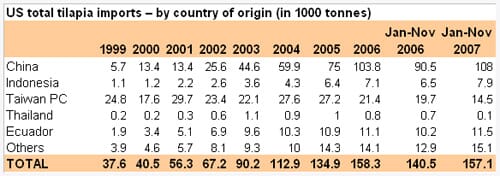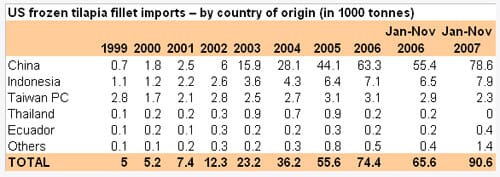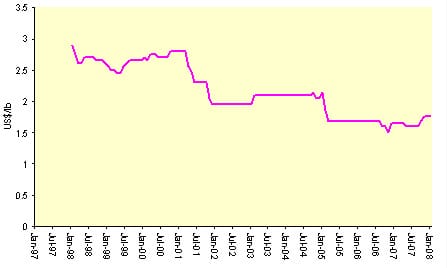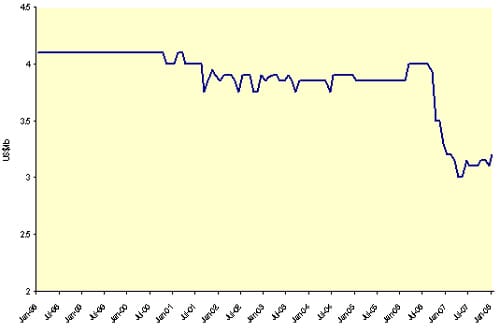In the first eleven months of the year, imports reached 157,100 tonnes, with a strong growth for frozen fillets, while whole frozen is losing ground.
 |
Chinese tilapia was excluded from the FDA checks on seafood products , as apparently the species is less subject to use of prohibited substances.
As a result, exports of tilapia from China to the US market continued to grow in the second half of the year, in contrast to that of other seafood products.
In the first eleven months of 2007, Chinese tilapia exports reached 108 000 tonnes, 19 per cent more than in the same period of 2006. No other supplier could match the Chinese tilapia boom.


China dominates the US frozen tilapia fillet imports, accounting for 90 per cent of total supply. Exports of this product from China grew by almost 42 per cent in the first eleven months of 2007 when compared with the same period of last year. Indonesia is a distant second for this product form.

Prices of frozen tilapia fillets have bottomed out, after continuous declines experienced in recent years. At present prices are increasing at a modest rate. Shortages on the traditional groundfish market combined with reduced arrivals of catfish from China since July 2007 create a good environment for further price increases of frozen tilapia fillets. The larger sized frozen fillets in fact reached US$ 2.10/lb in January 2008, up from a low US$ 1.95/lb in mid 2007.
Frozen tilapia fillets, wholesale price USA

China also dominates the frozen tilapia market in the USA, with an increasing share in total exports of this product to the US market (almost 70%). However, the trend is clearly for a reduced presence of whole tilapia in the market, and even Chinese exports of this product experienced an important decline.

Fresh tilapia fillets are in a different market segment all together. Their price is almost double that of frozen fillets. Latin American countries dominate this market, taking advantage of the relatively proximity to the US market, which reduces shipment costs. Fresh tilapia go to the restaurant trade, while frozen tilapia fillets are feeding the processing industry at the lower end of the price scale.
In the first eleven months of 2007, imports increased by 15% over the same period of 2006. This was mainly due to a recovery of Costa Rican tilapia production, after the disease problems of late 2005 and early 2006. Ecuador and Honduras also reported higher exports to the US market in 2007. Fresh tilapia fillet prices went up in the course of 2007, nevertheless some exporters of this product, such as Brazil, find a better market in their own country and have stopped exporting to the US market.

Chilled tilapia fillets, wholesale price USA

Further expansion of US market likely
The US market is likely to grow further. In the heated discussion about mercury content in fish and the benefits of fish consumption, tilapia got a good press. The US Department of Health says that pregnant women could eat tilapia, herring or whiting up to five times per week because those fish are very low in mercury, based on an adult serving size of 6 ounces. However, there is some discussion ongoing about the water quality of tilapia farming in China. Prices are likely to increase, as feed stuff is getting more expensive and wild whitefish is becoming scarcer on the market.
Further Reading
|
|
- You can view the full report by clicking here. |
January 2008

